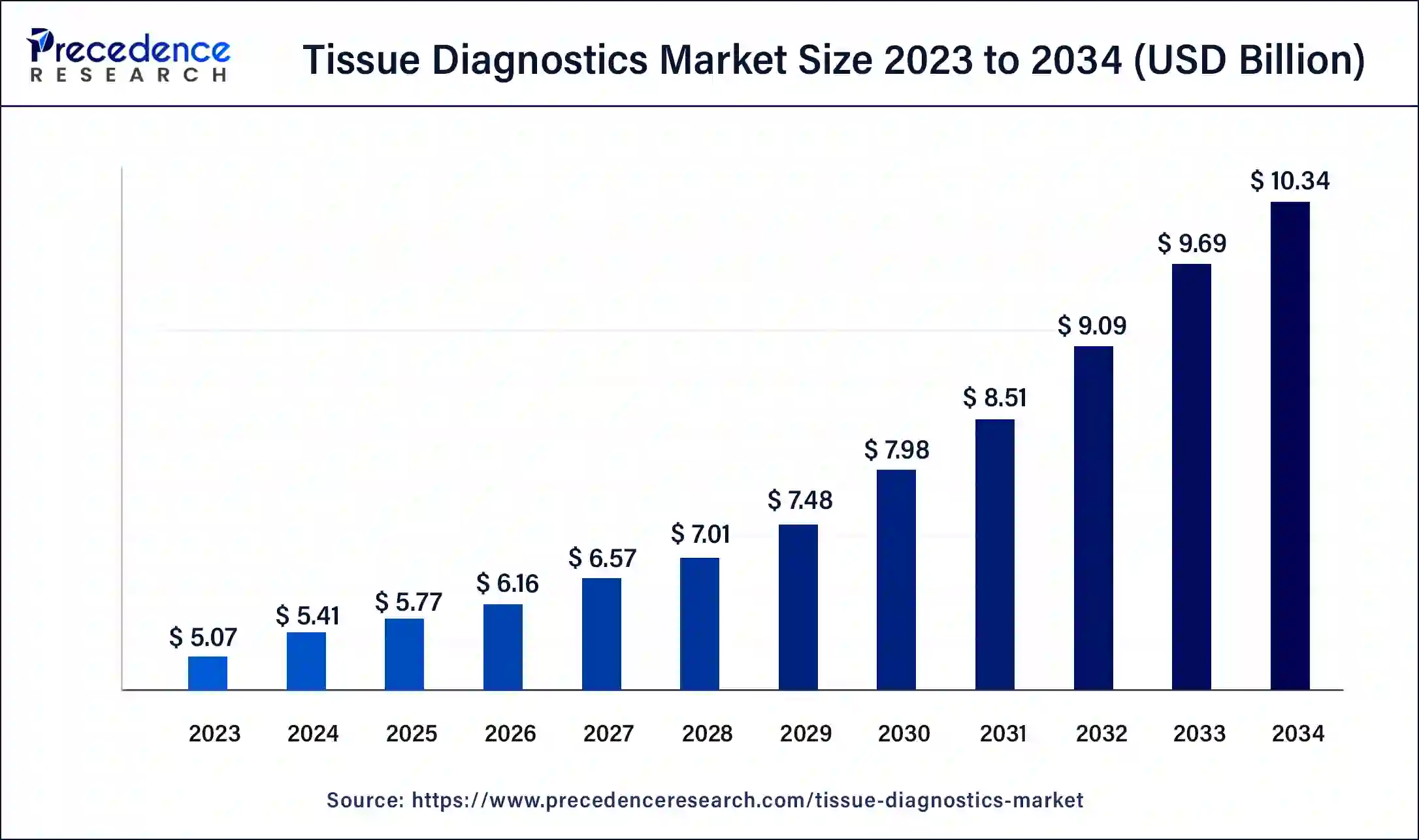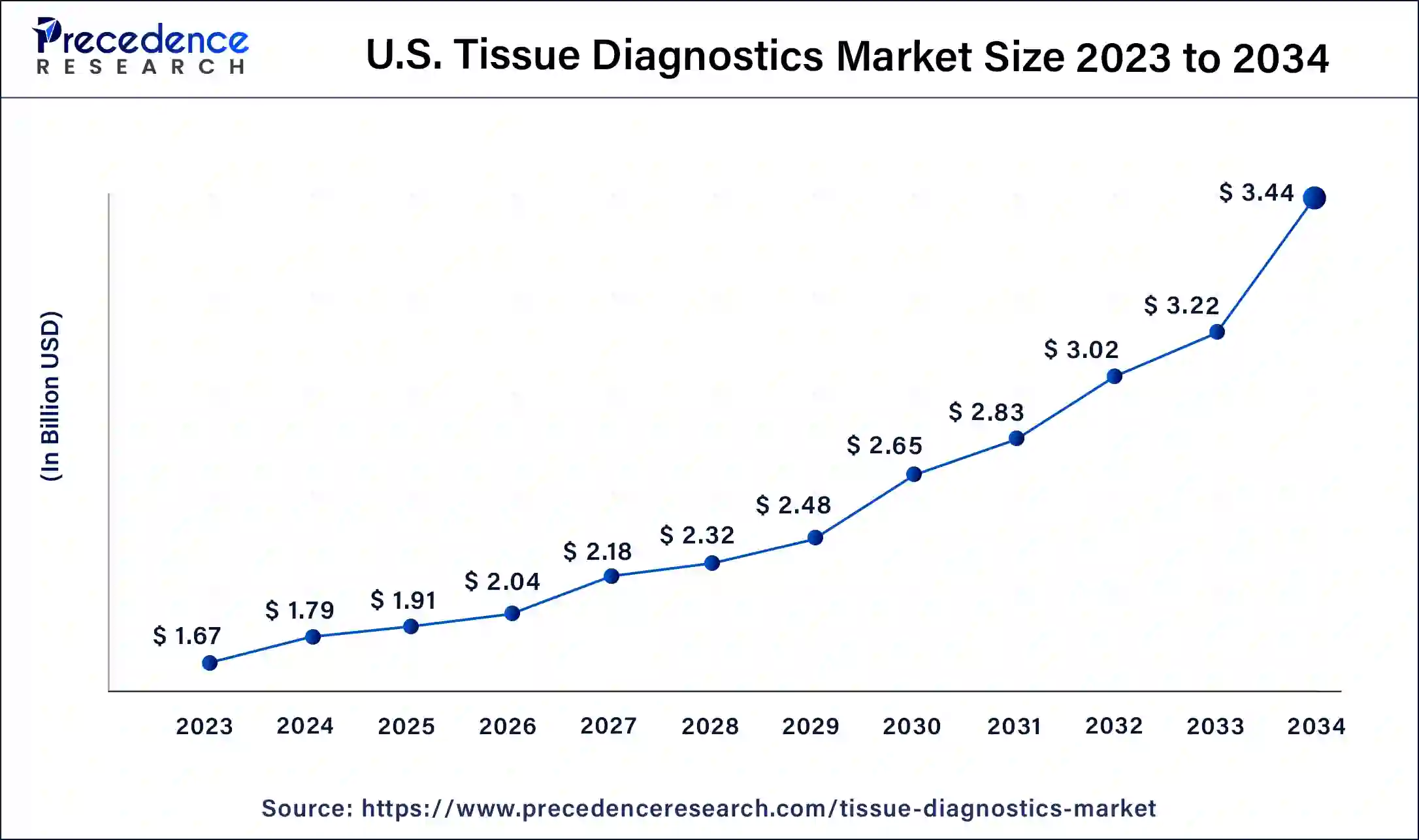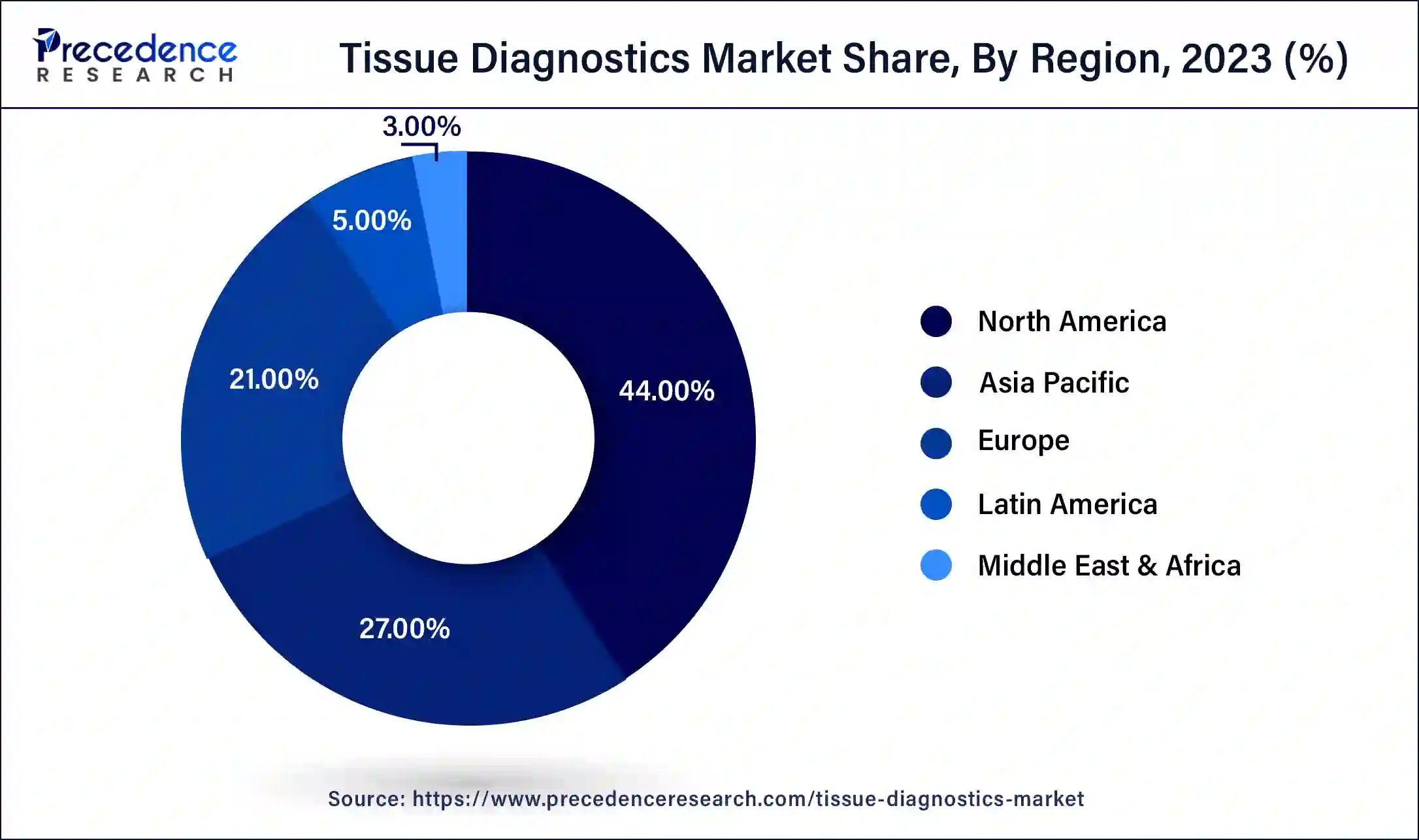Tissue Diagnostics Market Size and Forecast 2025 to 2034
The global tissue diagnostics market size was estimated at USD 5.41 billion in 2024 and is predicted to increase from USD 5.77 billion in 2025 to approximately USD 10.34 billion by 2034, expanding at a CAGR of 6.69% from 2025 to 2034.

Tissue Diagnostics Market Key Takeaways
- North America led the global market with the highest market share of 44% in 2024.
- By Applications, the breast cancer segment has held the largest market share in 2024.
- By Product, the Immunohistochemistry segment captured the biggest revenue share in 2024.
- By End-User, the hospital segment generated over 49% of revenue share in 2024.
Role of AI in Enhancing the Tissue Diagnostics Market
AI plays a transformative role in the market by improving accuracy, automating tasks, and propelling diagnosis, which can lead to more effective healthcare delivery and better patient outcomes. Furthermore, AI can automate tasks such as stain analysis, image analysis, and preliminary diagnosis, allowing pathologists to emphasize more complex cases that require high-level decision-making. AI can also optimize workload management, especially in high-volume pathology labs.
- In September 2024, Roche announced the expansion of its digital pathology open environment with the integration of more than 20 advanced artificial intelligence (AI) algorithms from eight new collaborators. These strategic partnerships aim to support pathologists and scientists in cancer research and diagnosis by leveraging cutting-edge AI technology.
U.S. Tissue Diagnostics Market Size and Growth 2025 to 2034
The U.S. tissue diagnostics market size was estimated at USD 1.79 billion in 2024 and is predicted to be worth around USD 3.44 billion by 2034, at a CAGR of 6.75% from 2025 to 2034.

North America dominated the global tissue diagnostics market and accounted for the largest revenue share in 2024. The growth is attributed to, an increasing geriatric population, and the raising prevalence of cancer among people is one of the major factors driving the tissue diagnostics market in this region. The presence of various community events leads to reduce cancer patients & increases the demand for cancer detection enhancements in the market for tissue diagnostics.
In addition, the Control Research Network and Cancer Prevention is an event by the domestic centers to prevent and control various diseases which emphasize on cancer prevention in North America. However, Modified drug basically relies on the use of human tissue for the growth of advanced tests. A rise in advanced technologies and healthcare IT systems in the clinical routine has significantly enhanced modified medicine, which drives the use of the tissue diagnostics market. The Medicine Enterprise in the United States enhances the personalized pharmaceutical industry.

Asia Pacific region is expected to hold a significant CAGR during the forecast period. The growth of this region is contributed to, access to a variety of tissue diagnostic tests offered by international industries has increased, which has helped to grow the tissue diagnostic market in this region. For instance, in 19 April 2019, Genecast and HalioDx SAS contracted for the commercialization of the Immunoscore diagnostic trials in China. Due to this program, the availability of this product has increased for cancer patients in china.
- In February 2025, IIT Madras launches a public access cancer genome database to help cancer research and drug discovery in India. Tissue samples and information are provided to researchers to facilitate cancer research and thus improve cancer diagnosis and treatment.
Market Overview
A tissue diagnosis treatment is a process that detects diseases in a patient's body through diagnostics and prevents further disorders such as cancer, tumors, biopsy, and other diseases. The increasing Geriatric population and rising prevalence of cancer among people has witnessed a high demand and rapid growth in the tissue diagnostics market. Tissue diagnosis plays a vital role in detecting cancer. The diagnosis treatment acts as one of the best standard procedures with the help of technology advancements such as increasing use of automated tissue-based diagnostic systems by the researchers which helps them to perform in-time diagnosis that detects early-stage cancer and other diseases. North America is expected to hold large market share revenue during the forecast period.
Market Scope
| Report Coverage | Details |
| Growth Rate from 2025 to 2034 | CAGR of 6.7% |
| Market Size in 2024 | USD 5.41 Billion |
| Market Size in 2025 | USD 5.77 Billion |
| Market Size by 2034 | USD 10.34 Billion |
| Base Year | 2024 |
| Forecast Period | 2025 to 2034 |
| Largest Market | North America |
| Fastest Growing Market | Asia Pacific |
| Segments Covered | By Application, By Product, By End-User |
| Regions Covered | North America, Europe, Asia-Pacific, Latin America, Middle East & Africa |
Market Dynamics
Drivers
Increasing prevalence of cancer among people driving the tissue diagnostics market
The increasing prevalence of cancer disease among people in developed regions is driving the growth of the tissue diagnostics market. Cancer is a dense disease that creates through the various stages of carcinogenesis procedures involving various trials. As a result, there are different obstacles along with a cancer diagnosis, therapy, and prognosis. However, cancer is one of the most common causes of death globally. According to the World Health Organization, it is found that more than 10 million people died in 2020 due to cancer. But if the cancer is detected early stage the mortality rate can be reduced. As a result, cancer screening and early detection is done by tissue diagnosis treatment, a process that helps in the detection of various biomarkers and proteins that assist in the identification of cancer. Laboratory tests, imaging, biopsy, genetic tests, and endoscopy are some of the common utilized cancer diagnostic tests. The increasing number of tissue diagnostic tests helps to boost the market growth.
Restraint
Lack of skilled professionals hampering the growth of tissue diagnostic market.
The limited skilled professional staff is a major factor in tissue diagnostic laboratories across emerging regions which is hindering the growth of the market, Moreover, a lack of awareness about tissue diagnosis systems in hospitals and laboratories leads to mistakes in the test reports and also hampers the market growth. The hospitals need to train people with the new advancement and systems adopted by the clinic for the diagnosis process. For instance, in 2020, in the United Kingdom, 4% of diagnostics laboratories has trained staff to provide their diagnostic processes and daily tasks.
Opportunity
Technological advancement in tissue diagnostics creating ample opportunities in the market
Various new technological advancements and update in tissue diagnostics systems is creating numerous opportunities in the tissue diagnostics market. Advancement in diagnostics treatment for effective diagnostic tests such as Immunohistochemistry, Fluorescence in situ hybridizations creates the opportunity to increase the market in upcoming years. For instance, In September 2017, the University of Texas invented a new way of diagnosis by developing a pen which is a handheld hardware device that can detect cancer in 10 seconds named Mas Spec pen, it is 100 times faster than the present technology. These new devices offer improvement in cancer treatment and reduce mortality which eventually creates new opportunities in the tissue diagnostic market.
Furthermore, the increased number of cancer biomarkers is creating many beneficial opportunities for treating cancer patients through advanced detection technology and devices. The detection of cancer biomarkers has been made possible by technological developments within the field of biotech, and these biomarkers are promoted. As a result, the new diagnostic biomarkers is creating lucrative opportunities for the expansion of the tissue diagnostics market.
- In January 2025, Quanterix Corporation and Akoya Biosciences announced a definitive merger agreement under which Quanterix will acquire Akoya in an all-stock transaction. The transaction will create the first integrated solution for ultra-sensitive detection of blood- and tissue-based protein biomarkers.
Application Insights
Based on the Applications, the global tissue diagnostics market is segmented into Prostate Cancer, Breast Cancer, Lung Cancer, Gastric Cancer, and other Cancers. The breast cancer segment is expected to hold a large revenue share during the forecast period for the global tissue diagnostics market. The growth of this segment is attributed to the increasing prevalence of breast cancer in women worldwide, this causes due to genetic issues and increases in inheritance & family background. According to the World Health Organization, breast cancer disease has infected 2.2 million women globally in 2020, with 6, 80,000 mortalities. This cancer has been detected in 7.9 million women in the last 5 years as of the end of 2020, making it one of the most common cancers caused across the globe. Thus, the increasing prevalence of breast cancer is driving the growth of the global tissue diagnostics market during the forecast period.
However, the prostate cancer segment held a significant revenue share, owing to the advancement in technologies. Biomarker detection has assisted the development of tissue diagnostic tests along with opportunities for market growth.
Product Insights
Based on the Product Insights, the global tissue diagnostics market is segmented into In Situ Hybridization, Immunohistochemistry, Primary and Special Staining, Anatomic Pathology, Digital Pathology & Workflow. The Immunohistochemistry segment accounted for substantial growth during the forecast period. The growth of this segment is backed by, applications in therapeutics, the development of cancer diagnostics, and clinical research organizations (CRO). The Immunohistochemistry segment is mostly favored over conservative enzyme staining methods as it precisely brings differences between various types of tumors While, the conservative methods identify a restricted number of enzymes, tissue structures, and proteins of tumors.
However, the digital pathology segment is projected to witness lucrative growth during the forecast period. The growth of this segment is attributed to, an increase in the integration of whole slide imaging among pathologists. In addition, Whole slide Imaging (WSI) extracts precise features of tumors & calculates every component of these structures and supports cancer detection, and delivers useful medical trials for tumors. Also, Top retailers play a key role in the expansion of the usage of digital technology by delivering advanced and new products. For instance, in 2019, a leading player in microscope optical & imaging technologies Nikon Instruments had launched a digital slide scanning system named OS-15-N in collaboration with OptraSCAN.
End-User Insights
Based on the End-User Insights, the global tissue diagnostics market is segmented into Research Laboratories, Hospitals, Contract Research Organizations, and Pharmaceutical Organizations. The Hospital segment is expected to hold the largest revenue share during the forecast period. The growth of this segment is attributed to, the large utility rates and consumption of tissue diagnostic systems by hospitals. Doctors are increasingly shifting to tissue-based diagnostic testing methods from conservative testing because tissue diagnostic tests decrease timelines as related to conventional procedures.
However, hospitals are also working on the basis of agreement strategies for improved disease detection, this factor also boosts the segment growth. For instance, in 2019, the Taipei Veterans General Hospital contracted with Philips to install the IntelliSite Pathology system in the hospital. This contract converted from pathology tissue detection to digital diagnostics in the Taipei Veterans General Hospital.
In addition, the Contract research organizations segment is expected to witness substantial growth during the forecast period. This segment delivers clinical trial services, research support, functions, and manages trials of companies. An increasing number of research studies and clinical trials in cancer therapy has considerably driven the tissue diagnostics market and supported to the acceleration of the growth of the CRO segment.
Tissue Diagnostics Market Companies
- Abbott Laboratories
- F. Hoffmann-La Roche Ltd.
- Thermo Fisher Scientific Inc.
- Danaher
- Siemens
- bioMérieux SA
- QIAGEN
- GE Healthcare
- Becton, Dickinson and Company
- Merck KGaA
Recent Developments
- In January 2024, Hera Biotech announced that it had reached an agreement to acquire the endometriosis diagnostic assets and associated IP of single-cell and AI-driven biomarker discovery company Scailyte, creating an important consolidation of the only two tissue-based diagnostic programs for endometriosis.
- In May 2024, Epredia, a global leader in precision cancer diagnostics and subsidiary of PHC Holdings Corporation and NovaScan, Inc., a company that develops breakthrough technology for cancer detection announced that they have signed a letter of intent for a U.S. exclusive commercial distribution agreement for MarginScan™, a medical device that will support physicians in real-time detection of non-melanoma skin cancer.
- In February 2023, Thermo Fisher Scientific announced that it had launched its new Thermo Scientific PrecisionScan Automated Slide Scanner. This new slide scanner is designed to provide high-throughput scanning of digital pathology slides.
- In May 2019, an in vitro diagnostic ROS1 immunohistochemistry assay called VENTANA ROS1 Rabbit Monoclonal Primary Antibody was introduced by Roche. This assay can help identify cancer patients that are ROS1-positive by detecting the presence of the protein ROS1 in tissue.
- In August 2019, In order to perform immunohistochemistry tests for identifying particular cancer biomarkers in tissue samples from cancer patients, Lunaphore Technologies SA introduced LabSat.
- In July 2018, the Aquaro Wishbone microtome blade-handling instrument was introduced by Aquaro Histology. The tool is used to insert and position blades without touching them, as well as remove and discard them.
- In March 2017, the first and only Cryostat, Tissue-Tek Cryo3 Flex Cryostat Mohs, was introduced by Sakura Finetek USA, Inc. The innovative cryostat system is employed to shorten the time required to obtain full sections while preserving priceless tissues.
Segments Covered in the Report
By Application
- Prostate Cancer
- Breast Cancer
- Lung Cancer
- Gastric Cancer
- Other Cancers
By Product
- In Situ Hybridization
- consumables
- Instruments
- Software
- Immunohistochemistry
- Instruments
- Slide Staining Systems
- Tissue Microarrays
- Tissue Processing Systems
- Slide Scanners
- Other Products
- Consumables
- Antibodies
- Reagents
- Kits
- Instruments
- Digital Pathology and workflow
- Whole Slide Imaging
- Image Analysis Informatics
- Information Management System Storage & Communication
- Primary and Special Staining
- Anatomic Pathology
- Instruments
- Microtomes & Cryostat Microtomes
- Tissue Processors
- Automatic Strainers
- Other Products
- Consumables
- Reagents & Antibodies
- Probes & Kits
- Others
By End-User
- Research Laboratories
- Hospitals
- Contract Research Organizations (CROs)
- Pharmaceutical Organizations
By Geography
- North America
- Europe
- Asia-Pacific
- Latin America
- Middle East & Africa (MEA)
For inquiries regarding discounts, bulk purchases, or customization requests, please contact us at sales@precedenceresearch.com
Frequently Asked Questions
Ask For Sample
No cookie-cutter, only authentic analysis – take the 1st step to become a Precedence Research client
 sales@precedenceresearch.com
sales@precedenceresearch.com
 +1 804-441-9344
+1 804-441-9344